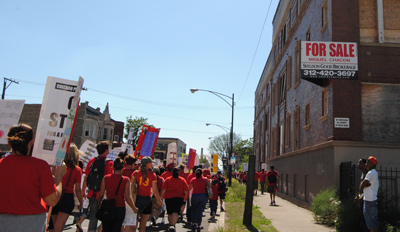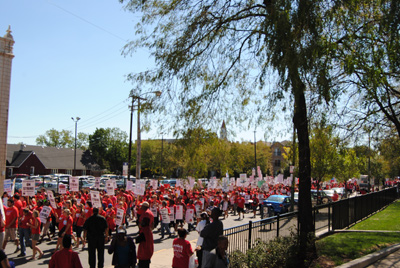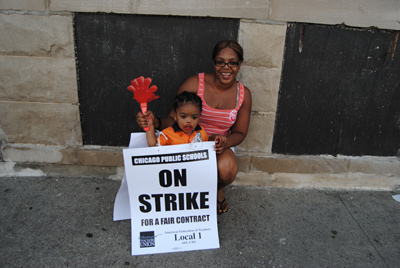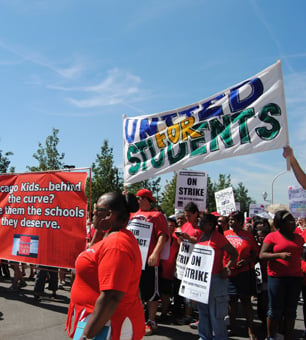There are only 205 social workers – school-based counselors or psychologists – to be shared by the 675 schools in the Chicago school district. But for some students and teachers, the needs can be as basic as computers that work and air conditioning on a hot summer day.
It was the best of times, it was the worst of times…
– A Tale of Two Cities, Charles Dickens
The temperature reached a high of 87 degrees on the third day of the Chicago Teachers Union strike, as the sun beat down on nearly 2,000 teachers marching through a neighborhood marred by empty lots and boarded-up windows.
The heat was uncomfortable, but nothing near what Raquel Gonzalez must bear in her unairconditioned classrooms. Gonzalez, 16, a senior at the selective enrollment school Lance Tech, said that was one of her central motivations for marching.
“Lane Tech is a selective enrollment school, so we get more resources,” said Gonzalez, noting that unlike many other schools, hers has working computers. “But our biggest problem is we don’t have air conditioning. We’re in school, it may be 75 and even 80 outside. It’s so hard to work when you’re drenched in sweat.”
 The lack of air conditioning, along with a host of other issues – including outdated textbooks, overcrowded classrooms and a lack of counselors for students facing record urban violence – dominated discussions at the rally against racial disparities in school funding and school closings.
The lack of air conditioning, along with a host of other issues – including outdated textbooks, overcrowded classrooms and a lack of counselors for students facing record urban violence – dominated discussions at the rally against racial disparities in school funding and school closings.
The march took place at John Marshall Metropolitan High School, a school on the city’s West Side slated for turnaround. The high school, with 91.2 percent of students considered low-income, will have all its staff fired, regardless of performance, and another group rehired.
In a system as segregated as Chicago Public Schools, where a quarter of a million students go to schools where 90 percent or more of their classmates are black or Latino, critics say it’s little surprise that the problems with schools fall along racial and income lines.
“There are no indications that this is about to change”
The education writer Jonathan Kozol devoted a chapter of his 1991 book “Savage Inequalities” to Chicago. In it he wrote:
One would not have thought that children in America would ever have to choose between a teacher or a play-ground or sufficient toilet paper. Like grain in a time of famine, the immense resources which the nation does in fact possess, go not to the child in the greatest need, but to the child of the highest bidder- the child of parents who, more frequently than not, have also enjoyed the same abundance when they were schoolchildren.
“A caste society,” wrote US Commissioner of Education Francis Keppel 25 years ago, “violates the style of American democracy…. The nation in effect does not have a truly public school system in a large part of its communities; it has permitted what is in effect a private school system to develop under public auspices…. Equality of educational opportunity throughout the nation continues today for many to be more a myth than a reality.” This statement is as true today as it was at the time when it was written. For all the rhetoric of school reform that we have heard in recent years, there are no indications that this is about to change.
 Though the district’s graduation rate has reached a record high of 60.6 percent after the 2011-2012 school year, the foreclosure crisis and chronic black unemployment have devastated the communities that go to Chicago Public Schools (CPS).
Though the district’s graduation rate has reached a record high of 60.6 percent after the 2011-2012 school year, the foreclosure crisis and chronic black unemployment have devastated the communities that go to Chicago Public Schools (CPS).
The recent spike in violence that made headlines, hit urban males particularly hard. The average age of people shot and killed in August was 25 years old.
The Chicago Youth Development Study estimated that 80 percent of teen boys living in the city have been exposed to urban violence. Meanwhile, there were only 205 social workers – school-based counselors or psychologists – to be shared by the 675 schools in the district.
Along with a lack of resources and professional staff in many schools, critics also argued that policies of turnarounds and school closings are hurting low-income communities.
Under Renaissance 2010, Mayor Richard J. Daley made plans to close 100 schools and replace them with selective enrollment or charter schools. Now-Mayor Rahm Emanuel has pledged to close another 100 of the worst-performing schools in the next five years.
But critics say this only leads CPS to pull badly needed resources out of schools deemed ‘failing,’ and that they create violence by pushing students across gang lines.
Pauline Lipman, an education professor at the University of Illinois Chicago and a member of Teachers for Social Justice, said there has been a pattern to the school closings.
“Since 2001 CPS has close over 10 neighborhood public schools, and all but two of them have been in low-income African-American and Latino communities,” said Lipman. “Schools are often the main places of stability in those communities and these closings have been devastating.”
They are also part of the push to usher in a whiter, cheaper workforce, said Lipman.
 “The closings left a pool of laid-off veteran teachers, many of them with deep knowledge and connections in these communities,” she said. “CPS moved to a school-based budgeting plan, which means the principal gets a budget and they have more discretion in how to spend it. What it means is that principals are under pressure to hire the cheapest teachers possible.”
“The closings left a pool of laid-off veteran teachers, many of them with deep knowledge and connections in these communities,” she said. “CPS moved to a school-based budgeting plan, which means the principal gets a budget and they have more discretion in how to spend it. What it means is that principals are under pressure to hire the cheapest teachers possible.”
Twenty-two communities on Chicago’s South, Southwest and West sides, the areas where school turnarounds were concentrated, saw nearly 80 percent of the city’s youth homicides, according to a Chicago Reporter investigation.
Union Demands
When the union and Emanuel held their respective press conferences to announce that the strike would go forward on Sunday night, Emanuel said the discussions were “not about the economic issues.” In recent days, CTU President Karen Lewis has put forth similar points, saying “we are not that far apart on compensation.”
While this may have been a note to delegitimize the strike – which is legally bound to be only on economic issues – it also spoke to the other gains the teachers are hoping to push through.
The two central issues are what happens to teachers displaced by closings and turnarounds, and teacher evaluations.
The CTU would like to see a system set up for the likely hundreds or more teachers that will be displaced – one that is similar to the system set up for teachers displaced by earlier closings and turnarounds.
In the interim agreement that CTU has with CPS, “any tenured teacher displaced in 2010 or after, who had a satisfactory rating or better, can apply for an open position; and as long as at least three qualified applicants apply for a position, the principal must hire a displaced teacher and cannot hire new teachers off the street.”
CPS and Emanuel, meanwhile, are pushing for principals to have autonomy over the teachers they hire and fire. In addition, it would offer displaced teachers to “take a severance pay of three months. They could also choose to be in the displaced pool for five months, where they would be given an interview for any job they applied for, and an explanation if they are not hired.”
The other issue is evaluations. CPS wants test scores to be 40 percent of a teacher’s evaluations, while the union wants to see test scores play a minimal role in teacher evaluations. Lewis estimates that CPS’ suggested rate of evaluation could lead to 6,000 layoffs.
She also said that judging teachers for their students’ test scores ignored some of the basic realities of urban poverty.
“There are too many factors beyond our control which will impact how our students perform on those tests,” said Lewis. “Evaluate us on what we do, not the lives of our children, which we do not control.”
What This Means for Unions
Four days into the strike of 30,000 teachers in Chicago, it’s been credited with a revival of the US labor movement, and with giving some of the poorest CPS students the chance to get resources, like enough textbooks to go around. It’s been called the first major direct challenge to the bank bailouts of 2008-2009; and a way to teach high school students what it means to stand up for themselves.
“The reform agenda is an attempt to change the whole of public education from one that involved the development of human beings, to one that is purely to develop people for the job market,” said Lipman. “Chicago is now the epicenter of the fight back against that plan.”
Since the strike was first announced, Lake Forest High School teachers in the Illinois suburb have gone on strike, Chicago janitors announced that they would stage a one-day solidarity strike in support of the teachers, and a poll released by the Chicago political web site Capitol Fax found that the majority of people were in support of the union.
Rebel Diaz, a duo of rappers educated in Chicago Public Schools, released a song in honor of the teachers, singing:
The teachers are tired, the students dumbfounded,
the budgets get cut so classes are overcrowded.
Streets full of violence, the blue code of silence
so i’m a keep rhyming ’til salaries start rising!
The unions uprising! takin’ to the streets!
The workers are united so the mayor’s got beef!
Rahm’s a fake pretender with a corporate agenda
Neo-Liberal offender, of course you offend us!
This ain’t about money! That’s far from the truth,
they want better work conditions to teach the youth.
…Homey I was taught by a Chicago teacher!
Chicago teacher, Chicago teacher!
I learned to read and write from a Chicago teacher,
So I’m inspired by the fight from our Chicago teachers!
And, perhaps most importantly, it’s inspired the next generation of Chicago Public School teachers.
“I’m out here because the teacher and the community inspire me to want to become a teacher and pursue this. As long as we stand up in solidarity and don’t give up and don’t break, I think we can win,” said Erika Oss, a fourth-year public policy student at Northwestern University who wants to go into teaching.
“Some teachers I’ve spoken to have asked me: Do you still wants to go into teaching? And I say: ‘Hell yeah, this makes me want to teach even more.'”
24 Hours Left: All gifts to Truthout now matched!
From now until the end of the year, all donations to Truthout will be matched dollar for dollar up to $22,000! Thanks to a generous supporter, your one-time gift today will be matched immediately. As well, your monthly donation will be matched for the whole first year, doubling your impact.
We have just 24 hours left to raise $22,000 and receive the full match.
This matching gift comes at a critical time. As Trump attempts to silence dissenting voices and oppositional nonprofits, reader support is our best defense against the right-wing agenda.
Help Truthout confront Trump’s fascism in 2026, and have your donation matched now!
